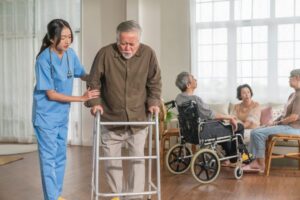
Finding the perfect assisted living facility shouldn’t feel like an overwhelming task, especially when you’re looking for something luxurious. The world of senior living has evolved, offering high-end services and posh accommodations that rival five-star hotels. Today’s luxury assisted living facilities aren’t just about care—they’re about lifestyle, comfort, and experiences that enrich daily life. Whether you’re looking for a place for yourself or a loved one, the key is knowing what to look for and how to spot the best of the best.
Here’s how to get started on your search for a premium senior living facility that combines care and class.
Finding Your Perfect Match
The first step in the process is to know exactly what you’re looking for. What kind of environment will make you or your loved one feel the most comfortable? Do you want something nestled in a quiet community or closer to the hustle and bustle of a vibrant city? Whether you’re dreaming of assisted living in Charlotte, North Carolina, Washington D.C., or anywhere in between, it’s crucial to match the facility to your lifestyle preferences.
Many high-end senior living communities offer amenities like gourmet dining, private balconies, wellness spas, and lush gardens. But beyond the luxury touches, pay close attention to the level of care. You’ll want to ensure that the facility offers personalized attention that aligns with specific medical needs. Luxury should never come at the cost of great care. The best places seamlessly blend high-quality services with a first-class living experience, offering residents the support they need without compromising their independence.
Luxury Meets Personalized Care
When you’re exploring options, it’s important to go beyond the surface. A high-end look is great, but what really makes a luxury assisted living facility stand out is the personalized attention it provides. Check how the staff interacts with residents and the kind of programs they offer. Is there a strong focus on individualized care? Are there wellness programs designed to keep the mind and body active?
Many of the top-tier facilities offer concierge services that go above and beyond, handling everything from transportation to specialized diets. It’s about living life to the fullest while ensuring all health and wellness needs are met. If you find a facility that’s passionate about treating each resident like an individual and providing tailored services, you’re on the right track.
The best luxury assisted living homes make you feel more like you’re in a resort than in a healthcare facility. It’s the small touches—fresh flowers in the common areas, chef-prepared meals, and a personal wellness coach—that make all the difference.
Where Lifestyle and Location Collide
Location plays a significant role in choosing the perfect luxury facility. Whether you prefer an urban setting or a peaceful suburban retreat, the best facilities will blend the lifestyle you want with convenience and style. Some of the top luxury living options are situated in scenic, serene areas with easy access to cultural hotspots, shopping, and dining. These spots offer residents the chance to stay connected with the outside world while enjoying their private oasis.
Atlanta, GA, and Miami are also known for this—offering a balance between upscale city life and sophisticated care. You’ll find communities that have on-site entertainment options, like theaters, fitness centers, and even golf courses. At the same time, they’re located near top-rated hospitals and medical centers, giving residents the peace of mind that world-class healthcare is always nearby.
When choosing a location, it’s not just about where it’s physically located but also what’s nearby. Does the community provide transportation for day trips to nearby attractions? Is it located near family or friends, making visits easy and frequent? The right facility will combine luxurious surroundings with a prime location that makes life more enjoyable.
First-Class Dining and Wellness Options
One of the biggest perks of living in a luxury assisted living facility is the world-class dining options available. Say goodbye to bland cafeteria food and hello to gourmet meals prepared by chefs who prioritize both taste and nutrition. Many high-end communities offer personalized meal plans, taking into account dietary restrictions and preferences. If organic, locally sourced ingredients are important to you, many luxury homes now cater to this trend, offering farm-to-table dining experiences.
Dining isn’t just about eating; it’s about creating a social experience that brings residents together. Many facilities offer elegant dining rooms with wait staff service, giving you the feel of a fine-dining restaurant. On top of that, you can expect a variety of cuisines and flavors, making each meal an experience in itself.
Beyond food, wellness amenities are a key factor to consider. Look for a facility that has a well-rounded approach to health—offering everything from fitness classes and swimming pools to yoga sessions and massage therapy. Many luxury communities have on-site spas where residents can indulge in facials, manicures, and massages. These services help ensure residents not only feel good but look their best, too.
Flexibility and Future Planning
It’s essential to think long-term. You want a place that can adapt as needs change. Many luxury communities offer a continuum of care, which means you can move seamlessly from independent living to assisted living and even to memory care or skilled nursing if needed. This flexibility ensures you won’t have to start your search all over again in the future.
Ask about how the facility handles transitions. Do they offer in-home health services if your care needs change? What kind of medical partnerships do they have? Being prepared for whatever the future holds will give you peace of mind, knowing that you or your loved one will be well taken care of down the road.
Another thing to think about is how a facility incorporates technology. Modern luxury living means having access to the latest innovations—whether that’s in healthcare or everyday convenience. Smart technology, such as voice-activated assistants, virtual doctor visits, and high-speed internet, can make life easier and more comfortable. Choosing a facility that stays ahead of the curve in this department is a great way to ensure long-term satisfaction.
Wrapping Up Your Search
When it comes to finding the perfect luxury assisted living facility, it’s all about the balance between care and lifestyle. The best places offer a blend of high-end amenities, personalized services, and a focus on well-being that goes beyond the basics. Whether you’re looking in a city or a serene suburb, you’ll want a facility that feels more like a home than a care center.
Take your time with the process—visit different communities, meet the staff, and get a feel for the atmosphere. In the end, it’s about finding a place where you can enjoy life to the fullest while knowing all your needs are being met. With the right choice, the golden years can truly be a luxurious experience.








